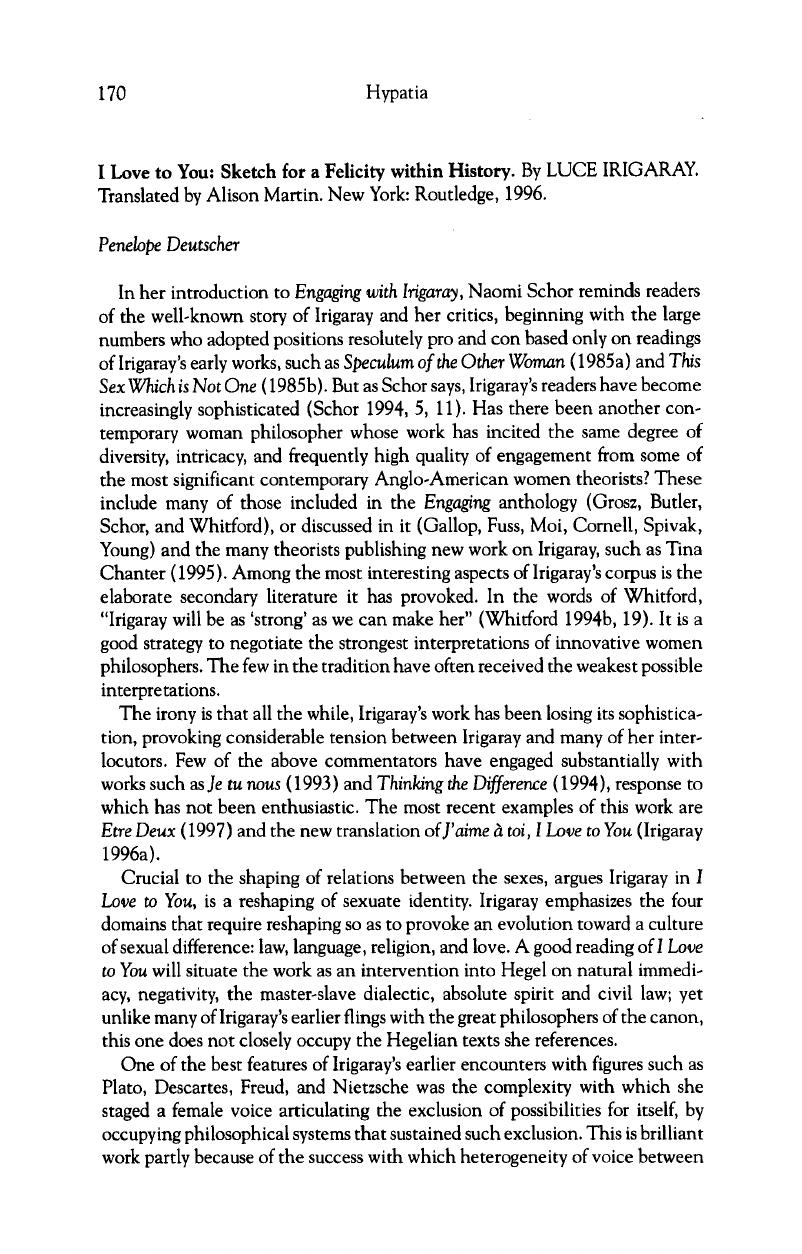No CrossRef data available.
Article contents
Luge Irigaray. Translated by Alison Martin. I Love to You: Sketch for a Felicity within History. New York, Routledge, 1996.
Published online by Cambridge University Press: 25 March 2020
Abstract
An abstract is not available for this content so a preview has been provided. Please use the Get access link above for information on how to access this content.

- Type
- Book Reviews
- Information
- Hypatia , Volume 13 , Issue 2: Special Issue: Border Crossings: Multiculturalism and Postcolonial Challenges, Part 1 , Spring 1998 , pp. 170 - 174
- Copyright
- Copyright © 1998 by Hypatia, Inc.
Footnotes
Permission to reprint a book review from this selection may be obtained only from the author.
References
Burke, Carolyn 1994. Translation unmodified: Irigaray in English. In Engaging with Irigaray, ed. Burke, Carolyn, Schor, Naomi and Whitford, Margaret, Burke, Carolyn, Schor, Naomi and Whitford, Margaret, eds. 1994. Engaging with Irigaray. New York: Columbia University Press.Google Scholar
Chanter, Tina 1995. Ethics of eros: Irigaray's rewriting of the philosophers. New York: Routledge.Google Scholar
Diprose, Rosalyn 1994. The bodies of women: Ethics, embodiment and sexual difference. New York: Routledge.Google Scholar
Gallop, Jane 1988. Thinking through the body. New York: Columbia University Press.CrossRefGoogle Scholar
Grosz, Elizabeth 1989. Sexual subversions: Three French feminists. Sydney: Allen and Unwin.Google Scholar
Grosz, Elizabeth 1994. Volatile Bodies: Toward a corporeal feminism. Sydney: Allen and Unwin.Google Scholar
Irigaray, Luce 1985a. Speculum of the other woman. Trans. Gill, Gillian C.Ithaca: Cornell University Press.Google Scholar
Irigaray, Luce 1985b. This sex which is not one. Trans. Porter, Catherine. Ithaca: Cornell University Press.Google Scholar
Irigaray, Luce 1993c. Je tu nous: Taoard a culture of sexual difference. Trans. Martin, Alison. New York: Routledge.Google Scholar
Irigaray, Luce 1994. Thinking the difference: For a peaceful revolution. Trans. Montin, Karen. New York: Routledge.Google Scholar
Irigaray, Luce 1996a. I love to you: Sketch ofa possible felicity in history. Trans. Martin, Alison. New York: Routledge.Google Scholar
Kirby, Vicki 1991. Corporeal habits: Addressing essentialism differently. Hypatia 6(3): 4–24.CrossRefGoogle Scholar
Schor, Naomi 1994. Previous engagements: The receptions of Irigaray. In Engaging with Irigaray. See Burke, Schor and Whitford 1994.Google Scholar
Whitford, Margaret, ed. 1991. Introduction. The Irigaray Render. Cambridge MA: Basil Blackwell.Google Scholar
Whitford, Margaret, ed. 1994a. Irigaray, utopia and the death drive. In Engagingwith Irigaray. See Burke, Schor and Whitford 1994.Google Scholar
Whitford, Margaret, ed. 1994b. Reading Irigaray in the nineties. In Engaging with Irigaray. See Burke, Schor and Whitford 1994.Google Scholar




